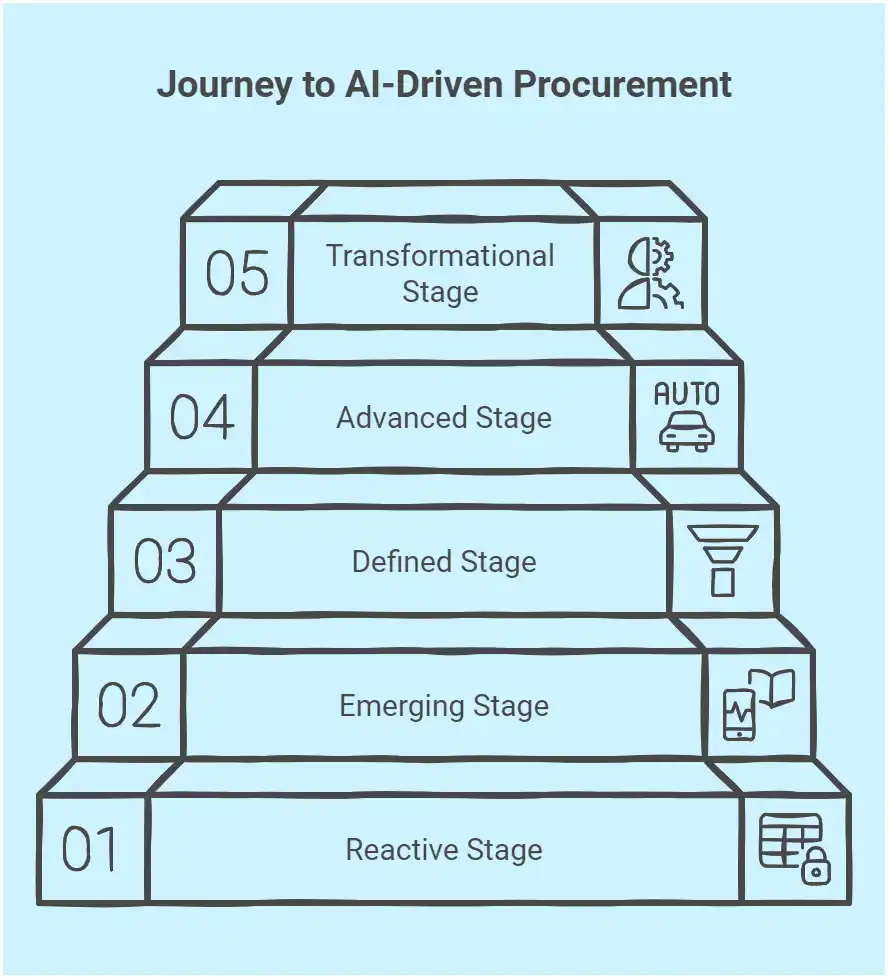Artificial intelligence (AI) is transforming procurement at an unprecedented pace. In fact, the latest McKinsey Global Survey on AI states that, 65 percent of respondents report that their organizations are regularly using gen AI are actively exploring or implementing AI technologies to improve efficiency and gain a competitive edge. Yet, AI adoption in procurement is more than just acquiring cutting-edge tools—it’s about fostering a holistic transformation that aligns technology with leadership vision, skills development, and infrastructure readiness.
Many organizations struggle to measure where they stand on this transformation journey, making it difficult to chart a clear path forward. Enter the AI procurement maturity model —a strategic framework that allows businesses to assess their current capabilities and systematically advance their AI readiness. This guide explores the AI procurement maturity journey, helping Chief Procurement Officers (CPOs) and their teams understand how to move from reactive processes to an AI-native ecosystem.
TL;DR
- The AI Procurement Maturity Model helps organizations assess and advance their readiness to adopt artificial intelligence in procurement.
- It outlines five key stages — Reactive, Emerging, Defined, Advanced, and Transformational — representing increasing levels of digital capability and strategic maturity.
- Progressing through these stages requires a balance of leadership commitment, skills development, and robust technology infrastructure.
- AI-driven tools such as predictive analytics, spend classification, and autonomous sourcing enable smarter decisions, efficiency, and resilience.
- A structured roadmap with current state assessment and prioritized technology investments ensures sustainable AI transformation.
- Companies using platforms like Zycus’ AI-powered Source-to-Pay suite can accelerate maturity, reduce risks, and build future-ready procurement ecosystems.
Understanding Maturity Stages of AI in Procurement
AI procurement maturity model is divided into five stages, each characterized by specific technological capabilities, leadership focus, and organizational readiness. Here’s a detailed breakdown of these stages:
1. Reactive Stage
Key Characteristics: At this stage, procurement processes are largely manual, relying on spreadsheets, basic digital tools, or siloed systems for spend analysis and reporting. Technology is reactive, used primarily for documenting past events rather than predicting future trends. For Example: A procurement team manually categorizing supplier invoices using basic reporting tools like Excel. Decision-making is based on past trends, without leveraging predictive or real-time analytics.
Technological Focus and skill level: Minimal investment in digital procurement solutions. Procurement professionals have limited exposure to digital tools or data-driven decision-making.
2. Emerging Stage
Key Characteristics: Organizations begin experimenting with targeted AI use cases, such as AI-powered spend classification or supplier risk assessments. These are often standalone solutions addressing isolated pain points. For example: Adoption of point solutions that classify spend data more accurately or flag high-risk suppliers based on predefined criteria.
Technological Focus and skill level: Investment in specific AI tools, such as contract analysis or supplier performance dashboards, that provide actionable insights for limited use cases. Teams start developing data literacy and AI awareness, though skills remain at a foundational level.
Download Whitepaper: Spend Data Classification: Unleashing Actionable Insights
3. Defined Stage
Key Characteristics: Procurement begins leveraging integrated AI platforms to predict supplier performance, optimize sourcing strategies, and improve spend management. AI is now embedded in core workflows. For Example: Using predictive analytics to forecast supplier reliability and prevent disruptions by proactively adjusting sourcing strategies.
Technological Focus and skill level: Deployment of integrated AI systems that combine predictive modeling, advanced spend analysis, and supplier collaboration capabilities. Teams demonstrate cross-functional data analytics expertise, enabling seamless collaboration between procurement, finance, and IT teams.
4. Advanced Stage
Key Characteristics: Procurement becomes predictive and autonomous, with AI handling complex decisions such as automated supplier selection and real-time risk mitigation. For example: AI autonomously selecting suppliers based on real-time performance metrics, ESG compliance, and cost optimization criteria.
Technological Focus and skill level: Advanced platforms with real-time analytics, machine learning algorithms, and autonomous decision-making capabilities. A data-driven culture where procurement professionals rely on AI insights for strategic planning.
5. Transformational Stage
Key Characteristics: Procurement operates as an AI-native ecosystem, with continuous innovation driven by AI-enabled systems and adaptive learning models. For example: Fully automated procurement processes powered by AI, including dynamic supplier collaborations and real-time contract management.
Technological Focus and Skill level: AI becomes a core competitive differentiator, integrating seamlessly with supply chain, finance, and operations systems. AI is a fundamental business capability, supported by advanced skills in AI governance and innovation.
AI in Procurement: What Are The Organizational Readiness Indicators?
Achieving AI maturity in procurement requires a balanced focus on leadership commitment, skills development, and technological infrastructure. Here’s how to measure readiness:
1. Leadership Commitment Metrics
Key Indicators:
- Percentage of procurement budget allocated to AI initiatives.
- Number of AI-focused training programs implemented annually.
- Clear KPIs to measure the impact of AI on procurement efficiency and cost savings.
Sample Indicator: An organization with 15% of its procurement budget dedicated to AI projects demonstrates higher maturity compared to one with less than 5%.
2. Technology Infrastructure Assessment
Technological Requirements:
- Cloud-based procurement platforms with advanced data integration.
- Robust data storage and maintenance protocols for optimal results.
Explore Cloud vs. On-Premise Procurement Solution
Evaluation Framework:
- Assess the organization’s current IT infrastructure against requirements for procurement AI maturity.
Note: Few organizations may even conduct regular audits to identify gaps in data storage, processing, and accessibility in this stage.
Strategies to Implement AI in Procurement
Advancing along the procurement AI maturity model requires deliberate action guided by a structured approach. Here’s a step-by-step guide to help organizations evaluate their current state, bridge skill gaps, and prioritize technology investments for impactful AI adoption.
1. Current State Assessment
Before charting a path forward, organizations must evaluate their current AI maturity level. This involves conducting a comprehensive diagnostic to map existing capabilities and identify gaps in leadership, skills, and technology infrastructure.
- Tools and Techniques: Leveraging industry-standard frameworks like the Gartner AI Maturity Model can provide an objective benchmark. Diagnostic tools should assess technology usage, procurement processes, and alignment with organizational goals.
- Capability Mapping: Breaking down procurement processes into components such as spend analysis, supplier management, and contract negotiation to evaluate where AI can add the most value. For example, is supplier performance tracked manually or through integrated dashboards?
- Outcome: A detailed capability map that clearly identifies areas requiring improvement or immediate attention, laying the foundation for targeted interventions.
2. Technology Investment Roadmap
Investing in the right AI technologies is crucial for achieving long-term success in the AI maturity journey. However, these investments must be aligned with organizational priorities and expected ROI.
- Prioritizing Technologies: Identify high-impact AI tools to address immediate needs and build future-ready capabilities. A sample prioritization could be:
- Immediate Need: AI-driven spend analysis tools to identify savings opportunities.
- Future Capability: Autonomous procurement platforms that can handle supplier selection and contract negotiation.
- Budgeting and ROI Calculation: Estimate upfront investments and the potential returns over time. For instance, an AI-powered spend classification tool might reduce manual errors and save thousands of hours annually, translating into measurable cost savings.
- Outcome: A clear technology roadmap with prioritized investments that maximize ROI while ensuring scalability for future AI capabilities.
Conclusion
The AI maturity model is a strategic roadmap for procurement leaders aiming to align technological capabilities with organizational transformation. By understanding where your organization stands, identifying gaps, and investing in leadership, skills, and infrastructure, you can confidently progress toward an AI-native procurement ecosystem.
Ready to take the next step? Book a demo today, begin your procurement maturity assessment today and unlock the potential of AI to transform your operations.
FAQs
Q1. What is the AI Procurement Maturity Model?
The AI Procurement Maturity Model is a strategic framework that helps organizations evaluate how ready they are to adopt and scale artificial intelligence (AI) in procurement. It defines the stages of maturity—from manual, reactive processes to fully autonomous, AI-native procurement ecosystems.
Q2. Why do organizations need an AI maturity model for procurement?
Procurement leaders often struggle to measure progress on their AI transformation journey. The maturity model provides a clear roadmap for assessing current capabilities, identifying skill and technology gaps, and setting priorities for investment and innovation.
Q3. What are the five stages of AI maturity in procurement?
The model typically includes five stages:
- Reactive: Manual, spreadsheet-driven operations
- Emerging: Experimentation with isolated AI tools
- Defined: Integrated AI platforms for predictive insights
- Advanced: Autonomous decision-making powered by AI
- Transformational: Fully AI-native ecosystem with continuous learning and innovation
Q4. How can businesses assess their current AI maturity in procurement?
Organizations can assess their maturity by conducting a diagnostic evaluation across leadership, skills, data infrastructure, and technology adoption. Frameworks like Gartner’s AI Maturity Model or Zycus’s proprietary maturity assessments help benchmark readiness and define improvement areas.
Q5. What are the key indicators of AI readiness in procurement?
AI readiness depends on three key factors:
- Leadership Commitment: Clear vision, defined KPIs, and budget allocation for AI initiatives.
- Skills Development: Procurement teams trained in analytics, AI tools, and data literacy.
- Technology Infrastructure: Cloud-based, integrated systems that support automation and predictive insights.
Q6. How does AI create value in procurement?
AI enhances decision-making, automates repetitive tasks, improves supplier risk management, and boosts compliance. It enables procurement teams to shift from tactical work to strategic roles—focusing on value creation, innovation, and sustainability.
Q7. What technologies support AI maturity in procurement?
Key technologies include:
- AI-driven spend analytics
- Predictive supplier risk management
- Autonomous sourcing and contracting
- Cloud-based procurement platforms
- Machine learning and natural language processing (NLP)
These technologies work together to deliver insights, speed, and resilience across the Source-to-Pay (S2P) cycle.
Q8. How can CPOs accelerate AI maturity in their organizations?
Chief Procurement Officers (CPOs) can accelerate maturity by:
- Establishing a clear AI vision and measurable KPIs
- Prioritizing data quality and integration
- Investing in team training and change management
- Partnering with AI-led platforms like Zycus for scalable deployment and support
Q9. What are the benefits of achieving higher AI maturity in procurement?
Organizations that reach advanced maturity levels experience:
- Faster decision-making and sourcing cycles
- Improved supplier collaboration
- Greater cost efficiency and risk visibility
- Predictive insights for smarter planning
- Stronger alignment between procurement and business strategy
Q10. What challenges do companies face on the AI procurement maturity journey?
Common challenges include siloed data systems, limited AI expertise, resistance to change, and unclear ROI measurement. Overcoming these requires leadership buy-in, robust data management, and a phased technology adoption plan.
Q11. How does Zycus support organizations in achieving AI procurement maturity?
Zycus offers an end-to-end AI-driven Source-to-Pay (S2P) platform that helps organizations advance through every stage of AI maturity. Its solutions for spend analysis, supplier risk, and contract automation enable CPOs to scale intelligence, reduce risk, and accelerate transformation.
Q12. What’s the next step after assessing AI procurement maturity?
Once an organization identifies its current maturity level, the next step is to create an AI transformation roadmap—prioritizing investments, training, and measurable KPIs. This ensures structured progress toward an AI-native procurement ecosystem.
Related Reads:
- Generative AI and Regulatory Compliance in Procurement
- Generative AI and the Evolving Role of Procurement Professionals
- Leveraging GenAI for Smarter Contract Negotiation and Risk Management
- GenAI For Sustainable Sourcing: Pathway to Enterprise Success
- The GenAI-Powered Future of S2P: Predictions for 2025 and Beyond
- Press Release – Zycus Unleashes Next-Generation Procurement Power with GenAI Innovations at Horizon 2024
- Webinar – Revolutionizing Procurement: How Generative AI Can Set Procurement Leaders up for Success
- eBook – 10X Source to Pay with GenAI
- eBook – Harnessing the Generative AI Revolution








































